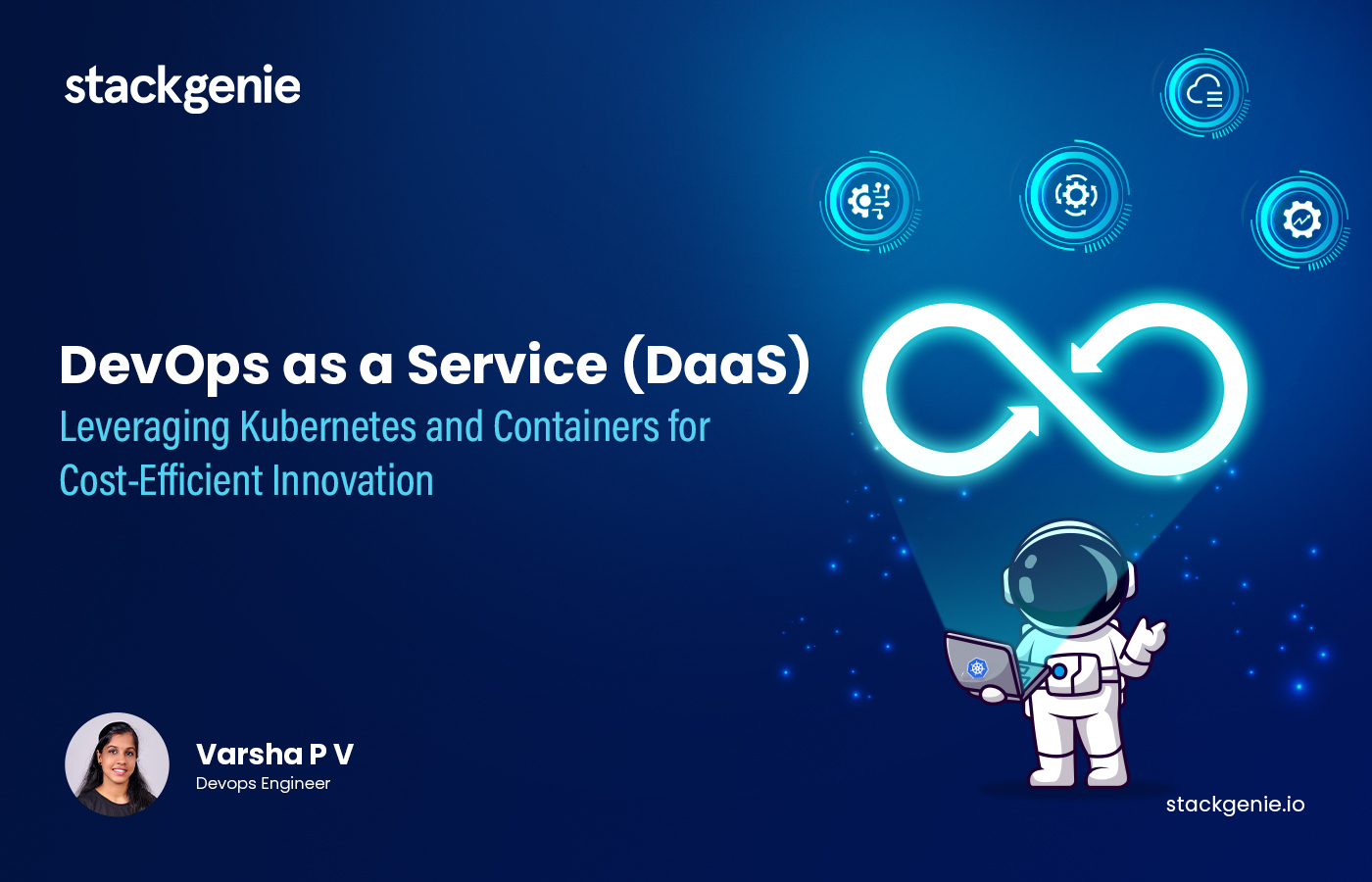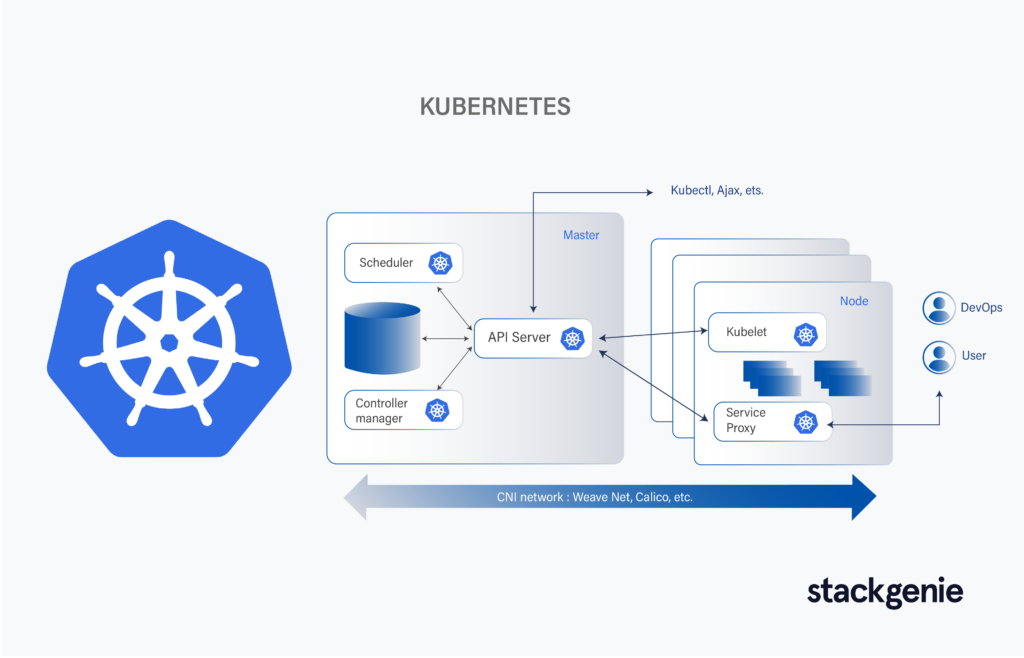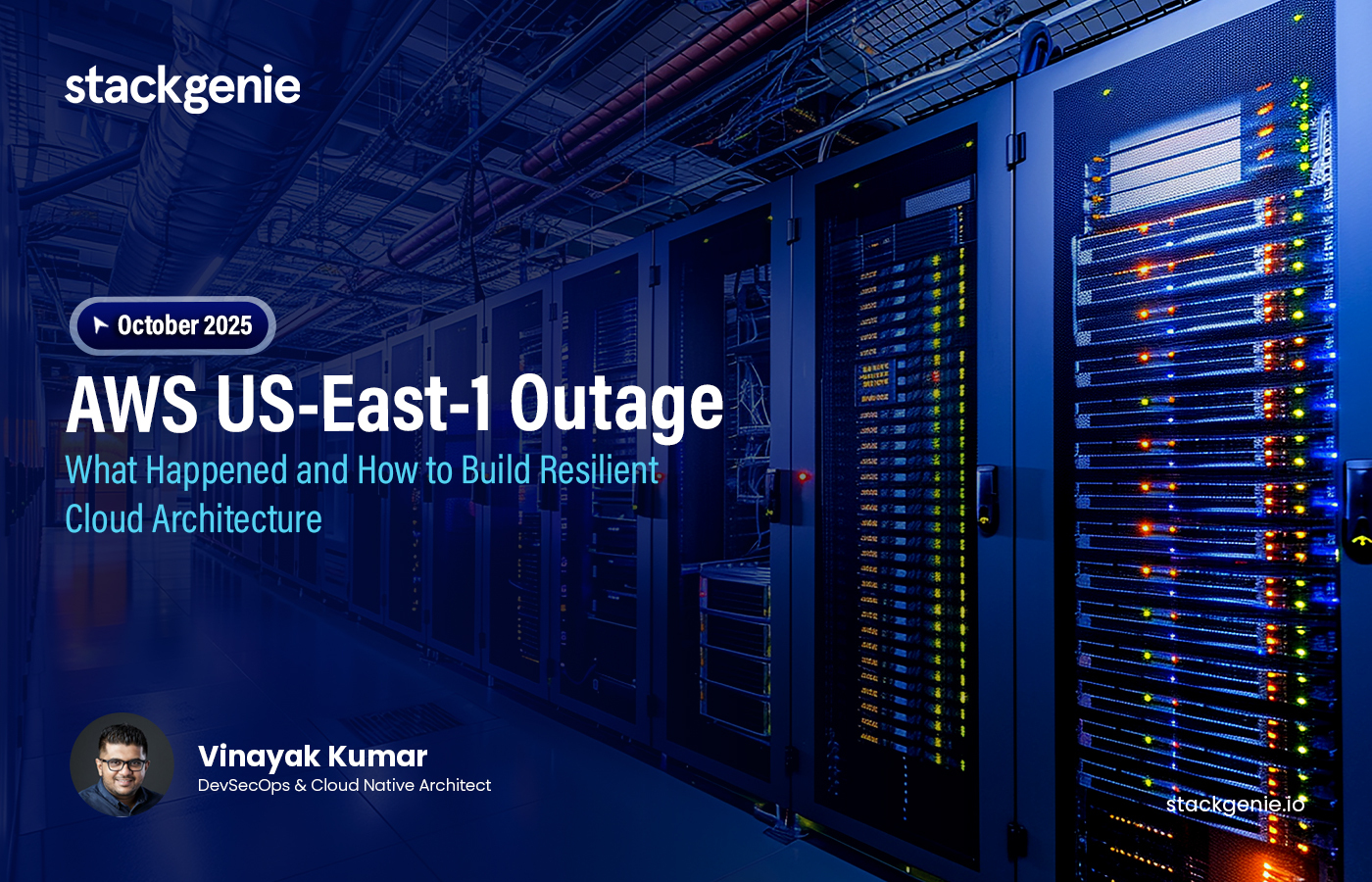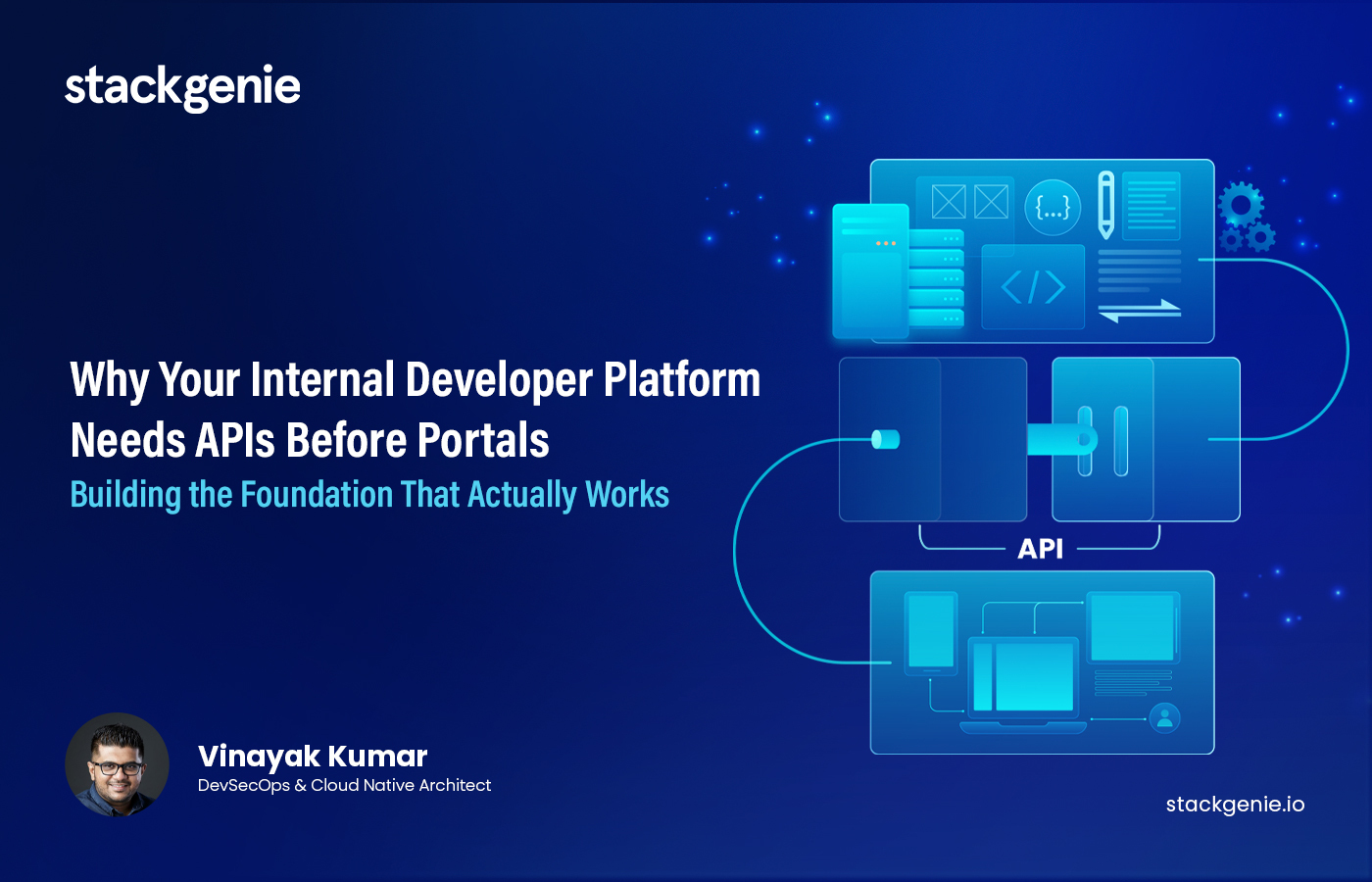Inside this article :
“The most powerful tool we can give developers isn’t a new framework or library—it’s time. Time to innovate, time to experiment, time to deliver value instead of wrestling with infrastructure.” — Sarah Chen, CTO
Imagine your development team spending their days building features users love instead of troubleshooting deployment issues. Picture your operations team sleeping soundly through the night instead of responding to 2 AM alerts. This isn’t a fantasy—it’s the reality for companies embracing DevOps as a Service powered by containers and Kubernetes.
In the rapidly evolving technology landscape, businesses need development and deployment solutions that enhance agility without sacrificing stability or security. DevOps as a Service (DaaS) has emerged as the answer for organizations seeking to streamline their software development lifecycle while minimizing infrastructure management overhead. At Stackgenie, we specialize in delivering cloud-native DevOps solutions powered by container technology and Kubernetes orchestration that drive innovation, reduce costs, and accelerate time-to-market.
What is DevOps as a Service?
DevOps as a Service (DaaS) represents a comprehensive approach to software development and IT operations delivered through cloud-based platforms and managed services. This model removes the burden of building and maintaining complex DevOps infrastructure in-house, allowing your team to focus on core business objectives rather than operational concerns.
DaaS delivers key components essential to modern software delivery:
- Automated CI/CD Pipelines for continuous integration and deployment
- Infrastructure as Code (IaC) for consistent environment provisioning
- Comprehensive Monitoring and Observability across all systems
- Security Integration throughout the development lifecycle
- Self-healing Infrastructure that reduces manual intervention
By adopting DaaS solutions, organizations gain the benefits of DevOps methodologies without the complexity of implementing them from scratch—significantly reducing both time-to-implementation and operational costs.
Containers: The Building Blocks of Modern DevOps
Understanding Container Technology
Containers represent lightweight, standalone executable packages that include everything needed to run an application—code, runtime, system tools, libraries, and settings. Unlike traditional virtualization, containers share the host operating system’s kernel, making them extraordinarily efficient and portable.
Containerization delivers several transformative benefits for DevOps workflows:
Efficiency and Resource Optimization
Containers consume significantly fewer resources than virtual machines:
- Smaller Footprint: Containers typically require megabytes rather than gigabytes
- Faster Startup: Containers initialize in seconds versus minutes for VMs
- Higher Density: Run 4-10× more application instances per host
This efficiency translates directly to reduced infrastructure costs—particularly important for businesses optimizing cloud spending.
Consistency Across Environments
The “it works on my machine” problem disappears with containers. By packaging application code with its dependencies, containers ensure consistent behavior across:
- Local development environments
- Testing and staging systems
- Production infrastructure
- Multi-cloud deployments
This consistency dramatically reduces environment-specific bugs and accelerates the development-to-production pipeline.
Enhanced Developer Productivity
Containers streamline the developer experience by:
- Eliminating complex environment setup procedures
- Providing isolated workspaces that prevent dependency conflicts
- Enabling simple version control of entire application environments
- Facilitating microservices architecture adoption
Our clients report up to 30% increases in developer productivity after implementing containerized workflows through Stackgenie’s DaaS solutions.
Kubernetes: Orchestrating at Enterprise Scale
While containers provide the packaging format for applications, Kubernetes delivers the orchestration layer needed to manage containerized workloads at scale. As the industry-standard container orchestration platform, Kubernetes automates deployment, scaling, and operations of application containers across clusters of hosts.
Key Kubernetes Capabilities for Business Success
1. Dynamic Scaling and Resource Optimization
Kubernetes excels at matching resources to actual demand:
- Horizontal Pod Autoscaling: Automatically adjusts the number of running containers based on CPU utilization or custom metrics
- Vertical Pod Autoscaling: Dynamically adjusts CPU and memory allocation for optimal resource utilization
- Cluster Autoscaling: Adds or removes nodes from your cluster as demand fluctuates
This capability ensures applications remain responsive during traffic spikes while minimizing costs during periods of low utilization—a perfect balance of performance and efficiency.
2. Self-Healing Infrastructure
Kubernetes continuously monitors application health and automatically remedies issues:
- Restarts failed containers
- Replaces and reschedules containers when nodes die
- Kills containers that don’t respond to health checks
- Only advertises services to clients when they’re ready to serve
These self-healing mechanisms dramatically reduce downtime and operational overhead, ensuring maximum system availability.
3. Advanced Deployment Strategies
Modern application deployment requires sophisticated rollout techniques that minimize risk and user impact:
- Rolling Updates: Gradually replace instances with new versions
- Blue/Green Deployments: Maintain two environments for zero-downtime transitions
- Canary Releases: Test new versions with limited user exposure
- Feature Flags: Control feature availability without code redeployments
Stackgenie implements these patterns through Kubernetes, helping businesses deliver features faster while maintaining stability.
4. Multi-Cloud and Hybrid Cloud Support
Kubernetes provides a consistent platform across diverse infrastructure:
- Public cloud providers (AWS, Azure, GCP)
- On-premises data centers
- Edge computing environments
- Hybrid combinations of all the above
This flexibility prevents vendor lock-in and enables strategic distribution of workloads based on performance, compliance, and cost considerations.
Business Advantages of Container and Kubernetes-Based DaaS
Accelerated Time-to-Market
The combination of containers and Kubernetes dramatically speeds up the software delivery lifecycle:
- Reduced Environment Configuration Time: From days to minutes
- Faster Release Cycles: Weekly releases become daily or even hourly
- Increased Deployment Frequency: Our clients average 200% more deployments after implementation
This acceleration enables businesses to respond rapidly to market changes, customer feedback, and competitive pressures.
Cost Optimization
DaaS implementations with containers and Kubernetes deliver significant cost benefits:
- Infrastructure Cost Reduction: 30-50% through improved resource utilization
- Operational Overhead Reduction: Less time spent on maintenance and troubleshooting
- Team Focus Optimization: Engineering talent applied to innovation rather than infrastructure
Most Stackgenie clients see ROI within 3-6 months of implementing our DaaS solutions.
Enhanced Security and Compliance
Container-based architectures improve security posture through:
- Isolation: Containing security breaches within affected containers
- Immutability: Eliminating runtime modifications that create vulnerabilities
- Declarative Configuration: Ensuring consistent security settings across environments
- Automated Scanning: Identifying vulnerabilities before deployment
Kubernetes enhances this security foundation with:
- Role-Based Access Control (RBAC): Granular permission management
- Network Policies: Micro-segmentation of application communication
- Secrets Management: Secure storage and distribution of credentials
- Pod Security Contexts: Controlling container privileges and capabilities
Enterprise-Ready Scalability
As businesses grow, their infrastructure needs evolve rapidly. Container and Kubernetes-based DaaS grows seamlessly with your organization:
- Linear Scaling: Add capacity without redesigning architecture
- Global Distribution: Deploy across regions for improved user experience
- Microservices Support: Break monoliths into manageable, independently scalable services
Real-World Success with Stackgenie’s DaaS Solutions
Case Study: FinTech Startup Accelerates Innovation
A financial services startup faced challenges with their traditional deployment process, with releases taking up to two weeks and frequent production issues.
After implementing Stackgenie’s container and Kubernetes-based DaaS solution:
- Deployment frequency increased from bi-weekly to daily
- Production incidents decreased by 78%
- Infrastructure costs reduced by 45%
- Time-to-market for new features decreased from months to weeks
The transformation enabled them to rapidly iterate on their product and secure additional venture funding based on their improved innovation velocity.
Case Study: E-commerce Platform Handles Seasonal Demand
An established e-commerce company struggled with scaling during peak shopping seasons, resulting in site slowdowns and lost revenue.
Stackgenie implemented a comprehensive DaaS solution with:
- Auto-scaling Kubernetes clusters
- Containerized microservices architecture
- CI/CD pipeline automation
- Advanced monitoring and alerting
Results included:
- Zero downtime during Black Friday (previously experienced 4 hours of degraded performance)
- 40% reduction in cloud infrastructure costs despite handling 3× more traffic
- 65% faster feature deployment
- Improved developer satisfaction and reduced turnover
Why Choose Stackgenie for DevOps as a Service
Stackgenie stands apart from other DaaS providers through our:
Comprehensive Expertise
Our team combines deep experience across:
- Cloud-native architecture design
- Kubernetes management and optimization
- CI/CD pipeline automation
- Security and compliance implementation
- Performance optimization
Customized Implementation Approach
We don’t believe in one-size-fits-all solutions. Our approach includes:
- Thorough assessment of current workflows and pain points
- Tailored roadmap development aligned with business objectives
- Phased implementation to minimize disruption
- Knowledge transfer and team enablement
Ongoing Support and Optimization
Our relationship extends beyond implementation with:
- 24/7 monitoring and incident response
- Regular system optimization reviews
- Security updates and vulnerability management
- Continuous improvement recommendations
Getting Started with DevOps as a Service
Modernizing your development and operations doesn’t have to be overwhelming. The journey to container and Kubernetes-based DevOps typically follows these stages:
- Assessment: Evaluate current workflows, pain points, and objectives
- Strategy Development: Create a tailored implementation roadmap
- Pilot Implementation: Start with non-critical workloads to demonstrate value
- Scale and Optimize: Expand to additional applications and environments
- Continuous Evolution: Regularly refine processes and incorporate new technologies
Stackgenie guides organizations through each stage, ensuring smooth transitions and maximizing business value at every step.
Conclusion: Transform Your Development Pipeline with Stackgenie
DevOps as a Service powered by containers and Kubernetes represents the future of efficient, secure, and scalable software delivery. By partnering with us, organizations gain access to industry-leading expertise and purpose-built solutions that accelerate innovation while reducing operational complexity and cost.
Whether you’re a startup looking to establish best practices from day one or an enterprise seeking to modernize legacy systems, our container and Kubernetes-based DevOps solutions provide the foundation for sustainable competitive advantage in today’s fast-moving digital landscape.
Contact Us Today to learn how our DevOps as a Service solutions can transform your software delivery capabilities and drive meaningful business results.



